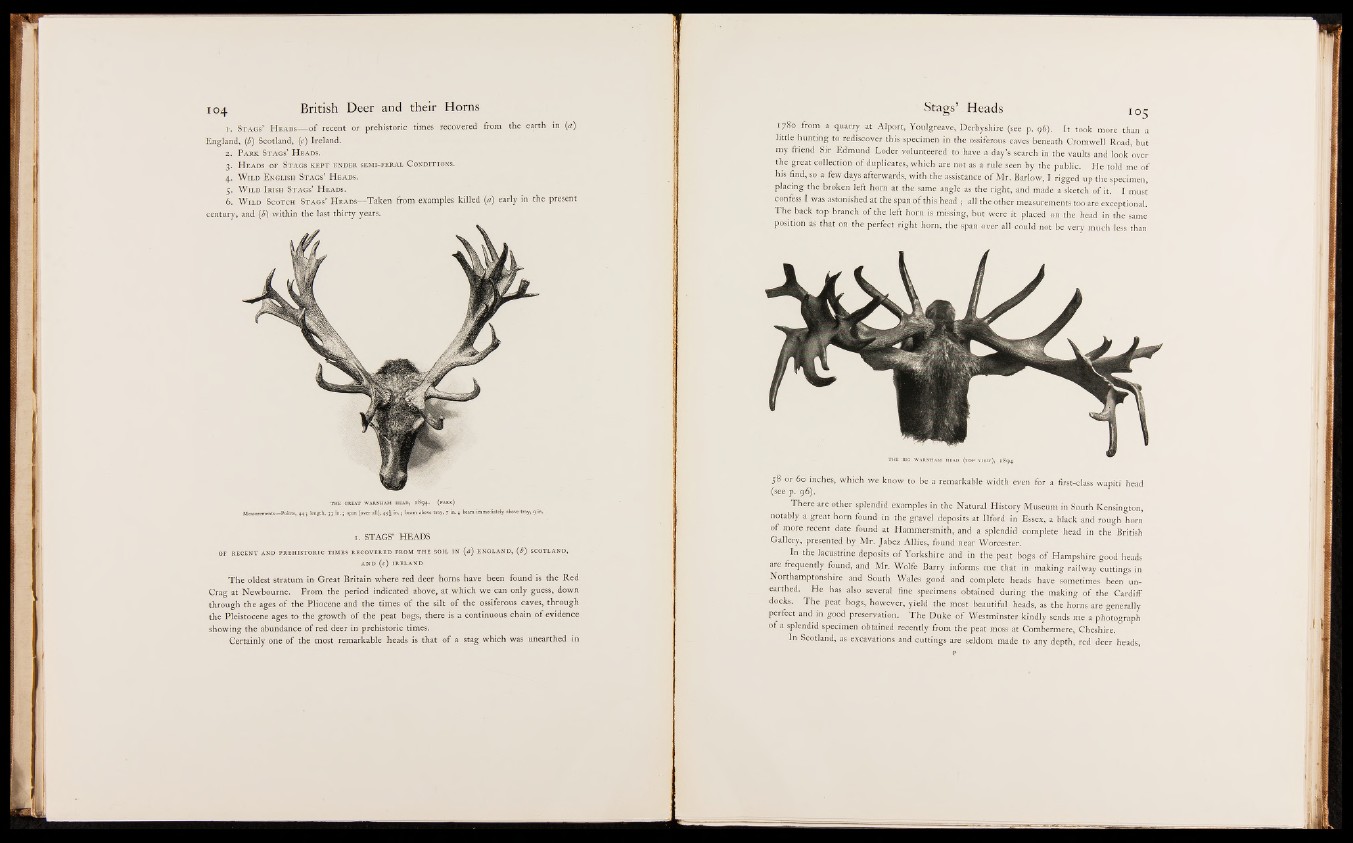
r. Stags’ H eads— o f recent or prehistoric times recovered from the earth in (a)
England, (b) Scotland, (c) Ireland.
2. Park Stags’ H eads.
3. Heads of Stags kept under semi-feral C onditions.
4. W ild E nglish Stags’ H eads.
5. W ild Irish Stags’ H eads.
6. W ild Scotch Stags’ H eads— Taken from examples killed (a) early in the present
century, and (£) within the last thirty years.
Measurements—Points, 44 ; length, 33 in.; span (over all), 45% in.; beam above tray, 7 in.; beam immediately above tray, 9 in.
i . S T A G S ’ H E A D S
OF RECENT AND PREHISTORIC TIMES RECOVERED FROM TH E SOIL IN (a) ENGLAND, ( ? ) SCOTLAND,
AND ( f ) IRELAND
The oldest stratum in Great Britain where red deer horns have been found is the Red
Crag at Newbourne. From the period indicated above, at which we can only guess, down
through the ages o f the Pliocene and the times o f the silt o f the ossiferous caves, through
the Pleistocene ages to the growth o f the peat bogs, there is a continuous chain o f evidence
showing the abundance o f red deer in prehistoric times.
Certainly one o f the most remarkable heads is that o f a stag which was unearthed in
B D * om *• 1 uan7 at Alport, Youlgreave, Derbyshire gee ,p. 96). It tobfc more than a
little hunting to rediscover this'specimen in th eRM lio S c a ^ llb e n e a th Cromwell Road, but
my friend Sir Edmund Loder volunteered to have a dapftseanh in the v l 4 s and look over
ih e great collection d g f upBcates, which are not as a rule seen by the publl<|!; He told me f e
his afterwards, with the afesirfancpf M r. Baris»*, I r iJ g fe ipp the spSmen,
placing the broken left horn at the same an g ]B |p h e right, and made a sketch o f it. I must
gjjrifess I was astonished at the span o f thisdiead ; all the other measurements tlf|.are exceptional.
The 8 Ci m ° l the left h° rn “ but w eH it p la c e B n the E H in the same
p os ition^ thats|j the perfect r^ht h o r^ the spanpsyer alheould not be very much lH th a n
THE BIG WARNHAM HEAD (TOP VIEW), 1 8 9 4
58 or 60 inches, which we know to be a remarkable width even for a first-class wapiti head
(see p; 96).
There are other splendid examples in the Natural History Museum in South Kensington,
notably a great horn found in the gravel deposits at Ilford in Essex, a black and rough horn
o f more recent date found at Hammersmith, and a splendid complete head in the British
Gallery, presented by Mr. Jabez Allies, found near Worcester.
In the lacustrine deposits o f Yorkshire and in the peat bogs o f Hampshire good heads
are frequently found, and Mr. Wolfe Barry informs me that in making railway cuttings in
Northamptonshire and South Wales good and complete heads have sometimes been unearthed.
He has also several fine specimens obtained during the making o f the Cardiff
docks. The peat bogs, however, yield the most beautiful heads, as the horns are generally
perfect and in good preservation. The Duke o f Westminster kindly sends me a photograph
o f a splendid specimen obtained recently from the peat moss at Combermere, Cheshire.
In Scotland, as excavations and cuttings are seldom made to any depth, red deer heads,
p